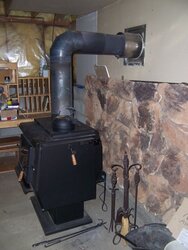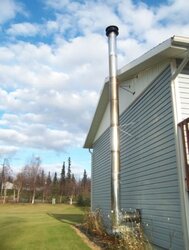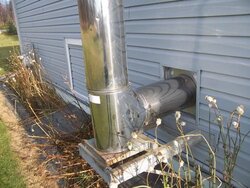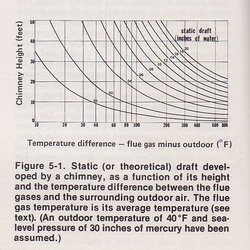Had Draft issues last night. Had to burn hotter but outside was warm 26°f &
Low pressure moved in. (opened windows to stay below 78 inside)
Called local Stove store guru.
Wanted pictures, so I sent them. Any pro or con to what he said appreciated.
Copied his response:
"Your stove is a newer vintage so it should be in good condition.
Your inside components should be all double wall black pipe an no single wall. The single wall allows for way too much air leakage affecting draft.
By going with 2-45 degree and less of a horizontal run would be best. Allow for a 1/2' rise for every 12" of horizontal run. Your choking your draft the way it is currently set up.
Your stove can be as close as 6" with the new double wall black pipe so this should help.
Your horizontal run through the wall is way too long.
Your TEE should be on a wall support kit and mounted 2" from the house with the pipe going through the eve.
There are way too many chimney components. Looks like a kaleidoscope of mixed pipe. Some may have gone through a chimney fire from the looks of it. I recommend that you use the longer 4 foot insulated pipe sections. This eliminated all the chimney sections that allow for air to come into the flue causing tremendous loss of draft.
Follow these recommendations and you will find out that your stove works just fine on a very low setting.
Adding a bit of height by at least 2' to this stock column and securing with a roof brace kit for wind support."
Not planning on moving the outside stack closer to house, (vinyl siding) but other recommendations sound good. Will have to buy pipe from him, not allot of choices. But that's OK. nice to have a source in our area.
Low pressure moved in. (opened windows to stay below 78 inside)
Called local Stove store guru.
Wanted pictures, so I sent them. Any pro or con to what he said appreciated.
Copied his response:
"Your stove is a newer vintage so it should be in good condition.
Your inside components should be all double wall black pipe an no single wall. The single wall allows for way too much air leakage affecting draft.
By going with 2-45 degree and less of a horizontal run would be best. Allow for a 1/2' rise for every 12" of horizontal run. Your choking your draft the way it is currently set up.
Your stove can be as close as 6" with the new double wall black pipe so this should help.
Your horizontal run through the wall is way too long.
Your TEE should be on a wall support kit and mounted 2" from the house with the pipe going through the eve.
There are way too many chimney components. Looks like a kaleidoscope of mixed pipe. Some may have gone through a chimney fire from the looks of it. I recommend that you use the longer 4 foot insulated pipe sections. This eliminated all the chimney sections that allow for air to come into the flue causing tremendous loss of draft.
Follow these recommendations and you will find out that your stove works just fine on a very low setting.
Adding a bit of height by at least 2' to this stock column and securing with a roof brace kit for wind support."
Not planning on moving the outside stack closer to house, (vinyl siding) but other recommendations sound good. Will have to buy pipe from him, not allot of choices. But that's OK. nice to have a source in our area.





 )
)
